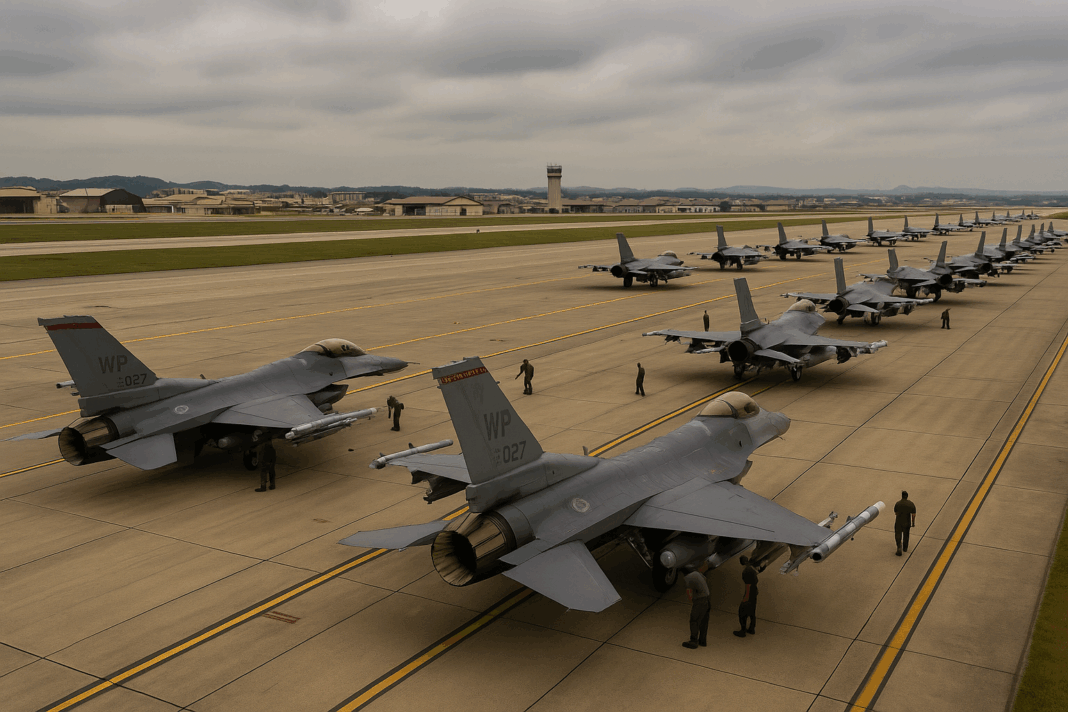The U.S. Air Force is making a big change at its largest air base in South Korea. A second “Super Squadron” of F-16 fighter jets is being formed at Osan Air Base.
A Major Shift in South Korea’s Air Defense Setup
This base is located near the border with North Korea and plays a key role in keeping watch over the region. Each super squadron is larger than a regular squadron, made up of 31 F-16 Fighting Falcons. That’s about one-third more aircraft than in a standard unit.
This change is part of a new idea that the Air Force started testing last year. The goal is to see if having more jets in one group can help get more flights done using fewer resources. So far, the first super squadron at Osan, formed in July last year, has shown that this setup can boost readiness and performance. Now, the Air Force is adding a second super squadron to the same base.
To make room for the new squadron at Osan, the Air Force is moving people and planes from another base called Kunsan Air Base. This base is about 115 miles southwest of Seoul. It has been home to two fighter squadrons—the 80th and the 35th. These squadrons are now sending their F-16s to Osan and will be shut down.
F-16 Super Squadron to Strengthen Osan Air Base with 62 Jets
Movement of Aircraft, Troops, and Equipment
The plan to form the second super squadron began with the arrival of nine aircraft and around 150 airmen from Kunsan to Osan in July. Now, a much larger group is moving. This includes more F-16s and about 1,000 airmen. These troops and jets will be fully in place at Osan by October.
Even though the Air Force called this move a “temporary measure” in an earlier update, the amount of equipment and personnel involved shows that the change is much more significant. While two squadrons are being deactivated at Kunsan, the Air Force is not closing that base. Instead, it will continue to be used for training, rotations, and storing weapons and materials.
Kunsan will still have its flightline operations active. That means planes, including F-16 fighter jets, can still take off and land there, and the base can still support operations when needed. It will also store important materials and munitions at different places across South Korea.
The second super squadron of F-16s marks a turning point in how the U.S. Air Force arranges its forces in the region. By bringing more F-16 jets and troops to one place, the Air Force hopes to make operations more efficient. This setup also makes it easier to manage equipment, train teams, and prepare for missions.
Turkiye Pushes Past F-16s, Wants Back into America’s Elite F-35 Club
Regional Impact and Strategic Concerns
While this change helps with day-to-day operations, it also brings up some concerns. Osan Air Base is now home to more F-16 jets and more troops. This makes it stronger during normal times, but it could also become a bigger target during a conflict. If tensions rise, a base with so many F-16 planes and people might be seen as an easy target for enemy forces.
Even with this risk, the super squadron idea aims to get the most use out of available resources. This means making the most of the F-16 aircraft, the people who fly and maintain them, and the facilities where they are based. By concentrating these resources at one base, the Air Force believes it can do more without needing as many separate units.
Despite the changes, Kunsan is not being left behind. It remains an important location in South Korea for the U.S. military. Even though its two main fighter squadrons are being inactivated, it will still serve an important role in supporting operations and storing supplies.
This update reflects the larger planning of the U.S. military in the Indo-Pacific region. It shows how the Air Force is adjusting its presence and using new ideas to meet its goals. With more powerful and efficient squadrons, the U.S. aims to stay ready for any situation that might come up in the region.
Vietnam’s Boldest Break: F-16 Deal Marks Dramatic Split from Russia’s Fading Grip
The second super squadron at Osan is a big and strategic move. It changes how the U.S. Air Force is organized in South Korea. It also shows a shift toward making fewer bases more powerful, even if it brings new risks with it. This development is already shaping how the U.S. military operates in one of the most sensitive parts of the world.

